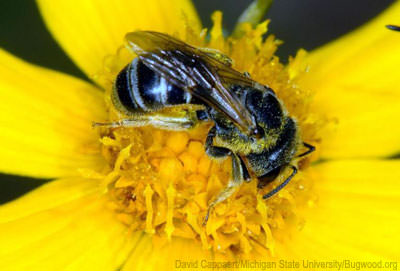
 Courtesy David Cappaert/Michigan State University/Bugwood.org Leafcutter bees are one of around 400 native bee species buzzing around North America. |
Ever since reading The Xerces Society’s guide “Attracting Native Pollinators,” I’ve been bee-obsessed. For years I’ve been able to identify Honey bees, bumblebees, green sweat bees and carpenter bees, but now, thanks to the book, I can add a handful of other bee species to my list.
 Photo by Jessica Walliser The curved leaf pieces missing from my epimedium plants were removed by the leafcutter bees building a nest in my porch swing. |
Last week, I noticed a few bees going in and out of small holes in the canopy of our metal porch swing. They weren’t at all interested in me so I was able to get close enough to them to discern a few distinguishing features. They had pale bands on their otherwise dark abdomens, and the underside of their abdomens were completely covered with yellow pollen. The tip of each abdomen bowed upwards, and I noticed that a few of them were carrying pieces of leaf as they flew into the hole.
There were only four bees and it seemed as if each bee was continually going in and out of the same hole. After leafing through the book, I discovered that four female leafcutter bees were building brood cells in the small openings of our porch swing. I mentioned it to my husband and told him that these lovely little native bees are not harmful to humans and we need to leave them alone. He wholeheartedly agreed.
Seeing these leafcutter bees reminded me that about 10 years ago, while working in a client’s garden, I found a line of leafcutter brood cells on the ground. My coworker and I spent a good amount of time marveling at the ingenious architecture of the cells. Each was constructed of cut pieces of leaf “glued” together to form a cup shape. The top of the cup was sealed with a circle of leaf. Four or five cups were nested on top of each other to form a line of cells. It was amazing, and though we didn’t know what it was at the time, there is no doubt we were both amazed at its complexity. It’s crazy to know that something so amazing is inside the pencil-width holes of our porch swing.




